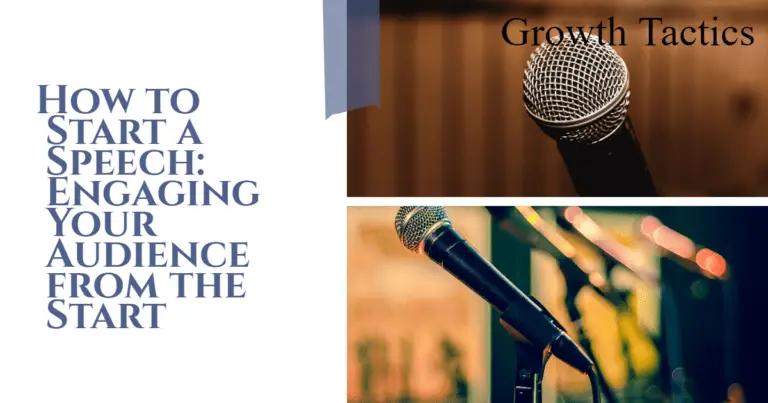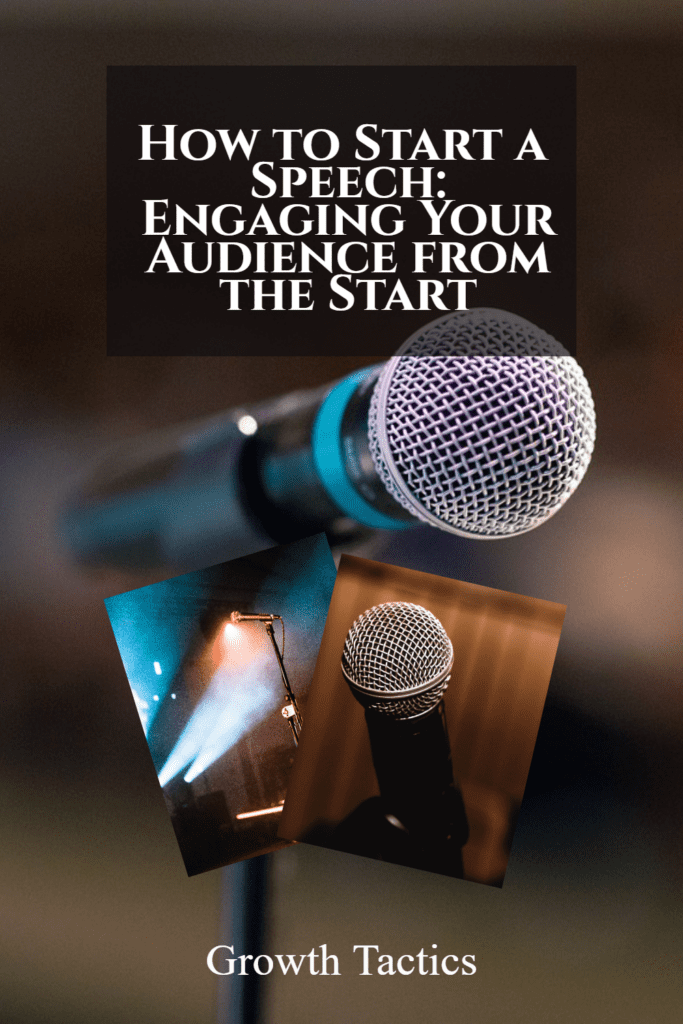Whether you’re a novice public speaker or a seasoned professional, knowing how to start a speech is crucial for capturing your audience’s attention and setting the tone for your presentation.
The opening minutes of your speech are your chance to make a memorable first impression and establish a connection with your listeners. In this article, we’ll explore different techniques and strategies to help you begin your speech with impact and confidence. So, let’s dive right in!
Jump To Section
The Power of a Captivating Speech Start
As the famous saying goes, “You never get a second chance to make a first impression.” This holds true for public speaking as well.
The way you start your speech can significantly influence your audience’s engagement and receptiveness. A strong opening not only grabs their attention but also sets the stage for the rest of your presentation.
Craft an Intriguing Introduction
The first step in starting a speech is to create an intriguing introduction that piques your audience’s curiosity. Here are a few effective techniques you can use:
1. Ask a Thought-provoking Question
One of the most effective ways to instantly engage your audience is by asking a thought-provoking question. Consider a question that relates to the topic of your speech and challenges the listeners to reflect on their own experiences or beliefs.
This will encourage active participation and make your audience feel invested in your speech.
2. Begin with an Anecdote or Story
Storytelling is a powerful tool for capturing the attention and emotions of your audience right from the start. Share a personal anecdote or a relevant story that connects with the theme of your speech.
This will help your listeners relate to your message on a deeper level and create a connection between you and the audience.
3. Start with a Surprising Statistic or Fact
Statistics and facts can have a profound impact on your audience and make them sit up and take notice. Begin your speech with a surprising statistic or an intriguing fact that is relevant to your topic. This will grab their attention and make them curious to learn more.
4. Use a Quote or a Powerful Statement
Quotes or powerful statements from renowned individuals can also be used to grab attention at the beginning of your speech.
Choose a quote that resonates with the theme of your presentation or a statement that challenges the status quo. This will intrigue your audience and encourage them to listen further.
15 Example Quotes to Start a Speech
“The future belongs to those who believe in the beauty of their dreams.” – Eleanor Roosevelt
“The only way to do great work is to love what you do.” – Steve Jobs
“Don’t watch the clock; do what it does. Keep going.” – Sam Levenson
“The greatest glory in living lies not in never falling, but in rising every time we fall.” – Nelson Mandela
“Your time is limited, don’t waste it living someone else’s life.” – Steve Jobs
“Success is not the key to happiness. Happiness is the key to success. If you love what you are doing, you will be successful.” – Albert Schweitzer
“The best way to predict the future is to create it.” – Peter Drucker
“Believe you can and you’re halfway there.” – Theodore Roosevelt
“The biggest risk is not taking any risk. In a world that’s changing quickly, the only strategy that is guaranteed to fail is not taking risks.” – Mark Zuckerberg
“Don’t be pushed around by the fears in your mind. Be led by the dreams in your heart.” – Roy T. Bennett
“The future depends on what you do today.” – Mahatma Gandhi
“Life is 10% what happens to you and 90% how you react to it.” – Charles R. Swindoll
“It’s not about how hard you hit, but how hard you can get hit and keep moving forward.” – Rocky Balboa
“You miss 100% of the shots you don’t take.” – Wayne Gretzky
“The best time to plant a tree was 20 years ago. The second best time is now.” – Chinese Proverb
Engage Your Audience with Interactive Elements
In addition to a captivating introduction, using interactive elements in your speech can help you establish a connection with your audience right from the start. Here are a few ideas to consider:
1. Ask a Show of Hands
To actively involve your audience, start by asking a show of hands related to your topic.
This simple gesture can make your listeners feel heard and encourage them to participate throughout your speech. It also provides you with valuable insights into the demographics or preferences of your audience.
2. Conduct a Brief Poll
Another way to engage your audience from the beginning is by conducting a brief poll. Use a show of hands or ask your viewers to respond digitally if you’re presenting in an online setting.
This not only creates an interactive element but also allows you to tailor your speech to better suit their interests and needs.
3. Encourage Group Discussion
Depending on the size and dynamic of your audience, you can divide them into smaller groups and encourage them to discuss a specific topic related to your speech.
This gives everyone a chance to participate actively and helps in fostering a sense of camaraderie among the attendees.
Tips for a Successful Speech Start
To ensure your speech start is as effective as possible, here are some additional tips to keep in mind:
1. Practice, Practice, Practice
As with any aspect of public speaking, practice is key. Rehearse your introduction multiple times until you feel comfortable and confident delivering it. This will help you overcome any nerves and deliver a smooth and engaging start to your speech.
2. Research Your Audience
Understanding your audience is crucial in tailoring your speech start to their interests and preferences. Research their backgrounds, demographics, and prior knowledge on the topic.
This will allow you to create an opening that resonates with them and makes them feel heard.
3. Keep it Concise and Clear
While it’s important to grab your audience’s attention, make sure your introduction is concise and to the point. Avoid rambling or going off on tangents.
Instead, focus on delivering a clear and compelling opening that sets the stage for the rest of your speech.
4. Be Authentic and Energetic
Lastly, be true to yourself and let your authentic personality shine through. Your audience will respond better to a speaker who is genuine and enthusiastic.
Infuse your speech start with energy and passion, and your listeners will be more likely to connect with you and stay engaged throughout your presentation.
Opening Lines of the 10 Popular TED Talks
TED Talks have become a global phenomenon, captivating audiences with their thought-provoking ideas and inspiring speakers. The opening lines of these talks play a crucial role in grabbing the audience’s attention from the very beginning.
In this section, we’ll explore the opening lines of the 10 TED Talks, analyzing why they are so effective and how they set the stage for these remarkable presentations. Let’s dive in and discover the power of a captivating opening line!
1. Ken Robinson: “Do schools kill creativity?”
“Good morning. How are you? It’s been great, hasn’t it? I’ve been blown away by the whole thing. In fact, I’m leaving.”
Ken Robinson’s opening line is unexpected and immediately captures the audience’s attention. By starting with humor and curiosity, he sets the stage for his talk on the importance of nurturing creativity in education.
2. Brené Brown: “The power of vulnerability”
“So, I’ll start with this: a couple of years ago, an event planner called me because I was going to do a speaking event.”
Brené Brown begins her talk on vulnerability with a personal story, immediately engaging the audience and creating a sense of connection. Her opening line draws the listeners into her narrative, setting the tone for her powerful exploration of vulnerability.
3. Simon Sinek: “How great leaders inspire action”
“How do you explain when things don’t go as we assume? Or better, how do you explain when others are able to achieve things that seem to defy all of the assumptions?”
Simon Sinek’s opening line is thought-provoking and asks a rhetorical question, immediately capturing the audience’s curiosity. By challenging assumptions, he sets the stage for his talk on leadership and motivation.
4. Mary Roach: “10 things you didn’t know about orgasm”
“So. I brought you some flowers. I’ll explain why later.”
Mary Roach’s cheeky opening line instantly grabs the audience’s attention and piques their curiosity. By injecting humor and intrigue into her talk, she sets the stage for her discussion on a topic that is both fascinating and taboo.
5. Sir Ken Robinson: “Bring on the learning revolution!”
“It’s been a great year for revolution. Google tells me there are 129,864 books on the subject.”
In this talk, Sir Ken Robinson starts with a playful line that references the concept of revolution in a broader sense. By leveraging humor and technology, he immediately engages the audience and sets the tone for his talk on education reform.
6. Amy Cuddy: “Your body language may shape who you are”
“So I want to start by offering you a free no-tech life hack, and all it requires of you is this: that you change your posture for two minutes.”
Amy Cuddy’s opening line offers the audience an immediate, practical takeaway. By using the term “life hack,” she taps into the audience’s desire for simple, actionable advice and introduces the topic of body language.
7. Dan Pink: “The puzzle of motivation”
“I need to make a confession at the outset here: a little over 20 years ago, I did something that I regret, something that I’m not particularly proud of.”
Dan Pink’s opening line grabs the audience’s attention by hinting at a confession or secret. By sharing his vulnerability, he instantly establishes a connection and sets the stage for his talk on motivation.
8. Cameron Russell: “Looks aren’t everything. Believe me, I’m a model.”
“The good news, according to the models in my agency, is that I’m only the second most-booked model in my agency.”
Cameron Russell opens her talk on beauty and identity with a humorous and self-deprecating line. By challenging societal expectations, she immediately engages the audience and creates a platform for her profound message.
9. Susan Cain: “The power of introverts”
“I want to start by offering you a free no-tech life hack, and all it requires of you is this: that you change your posture for two minutes.”
Susan Cain’s opening line captures the audience’s attention by referencing the concept of a “life hack.” She uses this simple instruction to introduce her talk on introversion and shed light on the power of quiet and contemplation.
10. Tony Robbins: “Why we do what we do”
“I got a call one day from a not so close friend of mine, and he said, ‘I’ve got an invitation for you to speak in New Orleans.'”
Tony Robbins starts his talk with a relatable anecdote, instantly drawing the audience into his narrative. By sharing a personal experience, he creates a connection and sets the tone for his talk on human motivation.
Final Thoughts
Starting a speech on the right note is essential for capturing your audience’s attention and keeping them engaged. By crafting an intriguing introduction, using interactive elements, and following these tips, you can ensure a successful start to your speech.
Remember, practice makes perfect, and with time and experience, you’ll become more comfortable and adept at starting your speeches with impact. So go ahead, captivate your audience, and deliver a speech they’ll remember long after it’s over.


